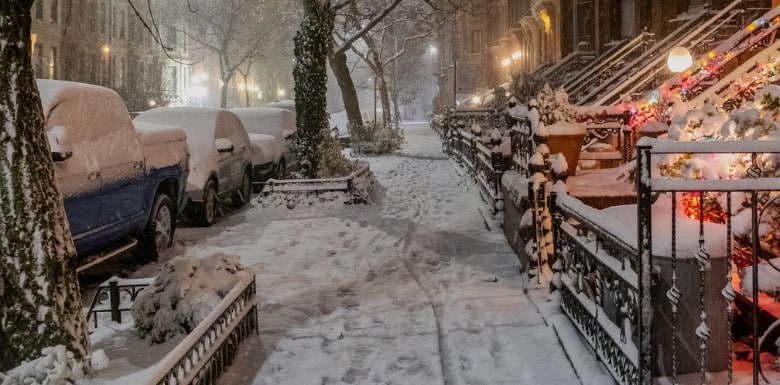Winter in New York brings snowy sidewalks, icy driveways, and frozen staircases that can create dangerous slip-and-fall hazards. If you’ve been injured in a fall due to snow or ice, you may wonder if you can sue for compensation.
With the right legal guidance, you may have grounds to seek damages for medical bills, lost wages, and pain and suffering
New York Law on Property Owners’ Duty to Maintain Safe Conditions
Property owners in New York have a legal duty to maintain safe conditions on their premises. This means they must clear snow and ice within a reasonable time after a snowfall.
They should ensure that walkways, steps, and other access points are free of hazardous ice patches. If they neglect this responsibility, they may be liable for injuries suffered on their property.
Legal Obligation to Keep Premises Safe
In New York, property owners must keep their sidewalks, walkways, and driveways free from dangerous conditions. This includes removing snow, ice, and debris after winter weather.
The New York City Administrative Code § 16-123 specifically states that property owners are required to:
- Clear sidewalks within four hours of daylight after a snowstorm.
- Take reasonable steps to prevent ice buildup on walkways.
Neglecting these responsibilities could result in fines and legal liability if someone is injured due to unsafe conditions.
What Does “Reasonable Snow and Ice Removal” Mean?
The concept of “reasonable” snow and ice removal can vary depending on the circumstances. Under New York law:
- Grace Period for Snow Removal: After a storm has ended, owners are given a certain amount of time to remove snow and ice.
- Appropriate Removal Measures: To address slippery spots, property owners should use salt, sand, or de-icing products.
New York courts typically evaluate factors like the time elapsed since the snow stopped and any specific risks the property owner was aware of when determining negligence in snow and ice removal cases.
Establishing Negligence in a Snow and Ice Injury Case
To successfully pursue a claim, the injured party and their lawyer must prove several elements to establish negligence. Each plays a critical role in the outcome of a slip-and-fall lawsuit:
- Duty of Care: The property owner had a legal duty to keep the premises safe.
- Breach of Duty: The owner failed to clear snow or ice within the legally required timeframe or ignored specific ice hazards.
- Direct Causation: The breach of duty directly led to the injury.
- Damages Suffered: The injured party must have measurable losses, such as medical bills and lost wages.
To successfully demonstrate negligence, each of these factors must be supported by solid evidence, such as photos, witness testimonies, and maintenance logs.
Common Injuries from Snow and Ice Falls
Injuries from snow and ice falls can range from minor bruises to severe, life-altering conditions, including:
- Broken bones
- Sprains and strains
- Head injuries
- Spinal injuries
You might be entitled to compensation if you suffered any of these injuries due to another’s negligence.
Who Is Responsible?
New York City’s Sidewalk Liability Law, found under § 7-210 of the NYC Administrative Code, places specific responsibility on property owners:
Applicability to Commercial and Residential Properties
This law applies to commercial and multi-family residential building owners, excluding single-family homeowners. If a slip-and-fall occurs due to icy conditions on the sidewalk, the building owner—not the city—could be held accountable.
Liability for Failure to Clear Sidewalks
If the property owner fails to clear the sidewalk or address ice patches promptly, they could face legal repercussions, including injury liability.
Exceptions and Special Circumstances: Storm-in-Progress Rule
New York law includes certain exceptions, such as the “storm in progress” rule, which could affect a snow or ice injury case:
- Active Snowstorm Exemption: Property owners generally aren’t responsible for injuries that occur during an ongoing snow or ice storm. This rule allows owners to clear hazardous areas once the storm has fully subsided.
- Responsibility After the Storm Ends: The property owner is expected to clear snow and ice within a reasonable timeframe. Failing to do so could result in liability for any resulting injuries.
Damages You Can Pursue After a Snow and Ice Injury
After a snow or ice-related injury, you may be able to seek damages for:
- Medical bills
- Lost wages
- Pain and suffering
- Rehabilitation expenses
- Future medical needs
Personal injury cases are civil matters, and the compensation you seek is based on the extent of your injuries and their impact on your life.
How a Personal Injury Lawyer Can Help
If you’re dealing with the aftermath of a snow or icefall, a personal injury lawyer can protect your rights and navigate the complex process of proving negligence. At HKD Personal Injury Lawyers, we have experience handling snow and ice injury claims and are here to help you get the compensation you deserve.
Contact us today for a free consultation at (212) 490-5700 or fill out our online form. We’ll review your case, answer your questions, and advise on your best legal options to recover your rightful damages.

